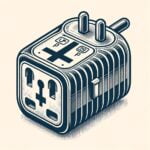Traveling to a foreign country can be an exciting and enriching experience, but it also requires some practical preparation. When it comes to traveling to Italy, one important consideration is the type of travel electricity used in the country. Understanding Italy’s electrical system is crucial for ensuring that your electronic devices are compatible and can be safely used during your trip.
Italy, like many other European countries, has its own unique electrical system with specific voltage and outlet types. To avoid any inconvenience or potential damage to your devices, it’s essential to familiarize yourself with these details before embarking on your Italian adventure. In this article, we will provide you with all the necessary information on Italy’s electrical system, as well as tips for safely using and charging your devices while visiting this beautiful country.
From voltage and outlet types to plug adapters and converters, there are several factors that travelers need to consider when it comes to travel electricity in Italy. By understanding these aspects of Italy’s electrical system, you can ensure that you are well-prepared and equipped to make the most of your electronic devices during your travels in this captivating destination.
So let’s dive into the details and make sure you have the knowledge you need for a smooth and enjoyable experience with travel electricity in Italy.
Voltage and Outlet Types in Italy
When planning a trip to Italy, it is essential to understand the country’s electrical system to ensure that you can use your electronic devices without any issues. Italy operates on a voltage of 230V and a frequency of 50Hz, which differs from the standard voltage in North America and some other countries. It is crucial to be aware of these differences to avoid damaging your devices while traveling in Italy.
Outlet types in Italy are typically Type F outlets, also known as “Schuko” outlets, which are compatible with plugs that have two round prongs. Some older buildings may still have Type L outlets with three round prongs, so it is advisable to carry a universal adapter that can accommodate both types of outlets. Without the proper adapter, travelers may find it difficult to charge their electronic devices or use their appliances during their stay in Italy.
Traveling to Italy: Plug Adapters and Converters
To ensure that you can use your electronic devices from home in Italy, it is important to pack the necessary plug adapters and converters. A plug adapter allows you to physically connect your device’s plug to the Italian outlet, while a converter can help regulate the voltage if your device is not compatible with the higher voltage used in Italy.
However, many modern electronic devices such as laptops and smartphones are already designed to handle different voltages, making them suitable for use in Italy without the need for a converter. Nonetheless, it is still essential to check the specifications of each device before plugging them into an Italian outlet.
Plug Adapters and Converters
When traveling to Italy, it’s important to understand the electrical system and what type of plug adapters and converters you may need in order to use your electronic devices. Italy operates on a 230-volt system with a frequency of 50 Hertz, which is different from the standard voltage in the United States. This means that most American devices will not be compatible with the Italian electrical outlets without the use of an adapter or converter.
Understanding Voltage and Outlet Types
In Italy, the standard outlet type is Type F, which has two round prongs. It’s essential to have the appropriate plug adapter to fit into these outlets. Additionally, some older buildings in Italy may still have Type L outlets, which require a three-pronged adapter. Make sure to research the specific outlets that will be available in the area you are visiting.
Plug Adapters vs. Converters
A plug adapter simply allows your device’s plug to fit into different types of outlets, while a converter actually changes the voltage coming from the outlet to match that required by your device. For most modern electronic devices, such as smartphones and laptops, a simple plug adapter should suffice because they are designed to handle varying voltages. However, for appliances with heating elements or motors, like hairdryers or electric shavers, you may need a voltage converter as well.
It’s also important to check if your device has a built-in voltage switch before using a converter. Some devices can handle both 110-volt and 230-volt systems without needing an additional converter. Always read the label on your device or consult the manufacturer for guidance on compatibility with different voltage systems.
Tips for Charging Devices in Italy
Italy’s electrical system operates on a voltage of 230 volts, with a frequency of 50 Hertz. This means that travelers from other countries, such as the United States or Canada, will need to be aware of the differences in voltage and outlet types to ensure they can charge their devices safely while in Italy.
When traveling to Italy, it is important to have the right plug adapters and converters to ensure that your electronic devices are compatible with the local electrical system. Here are some tips for charging your devices in Italy:
- Purchase a universal adapter: A universal adapter will allow you to use your electronic devices in multiple countries, including Italy. This versatile adapter can accommodate different plug types and fit into various outlet shapes.
- Check your device’s compatibility: Before plugging in any electronic device, make sure to check the voltage requirements. If needed, use a converter to adjust the voltage to match Italy’s 230-volt system.
- Use USB chargers: Many electronic devices, such as smartphones and tablets, can be charged using USB cables. This can be a convenient option for travelers as most modern hotels and accommodations offer USB outlets for charging.
Keeping these tips in mind when traveling to Italy will help ensure that you can charge your devices safely and effectively during your trip. Being prepared with the right adapters and converters will save you from any potential issues with incompatible electronics.
Safety Precautions When Using Electrical Appliances
When traveling to Italy, it is important to understand the country’s electrical system in order to take the necessary safety precautions when using electrical appliances. Italy operates on a 230V supply voltage and 50Hz frequency, which is different from the standard voltage used in the United States and Canada. This means that travelers from these countries will need to be aware of the differences in order to safely use their electronic devices.
It is crucial to check the labels on your electrical devices to ensure that they are compatible with the voltage and frequency in Italy. Using incompatible devices can not only damage your electronics but also pose a safety hazard. Additionally, investing in a voltage converter or transformer can help regulate the flow of electricity and protect your devices from damage.
Furthermore, always ensure that your electrical appliances are in good working condition before plugging them into Italian outlets. Frayed cords or damaged plugs can lead to electric shock or even start a fire. It is wise to inspect all your electronics before departure and replace any items with visible damage. Following these safety precautions will help ensure a safe and hassle-free experience when using electrical appliances during your travels in Italy.
| Italy’s Electrical System | 230V Supply Voltage, 50Hz Frequency |
|---|---|
| Voltage Converters/Transformers | Regulate flow of electricity |
| Safety Tips | Check appliance compatibility, inspect for damage |
Power Outages and Emergency Preparedness
When traveling to Italy, it is important to be prepared for power outages and emergencies. Italy, like any other country, can experience unexpected electrical interruptions due to various factors such as severe weather or maintenance issues. Being prepared for these situations can help ensure that your trip goes as smoothly as possible.
In the event of a power outage, it is important to have a few essential items on hand. One of the most important things to have during a power outage is a flashlight or headlamp. This will provide you with much-needed light in dark situations. Additionally, having a portable charger for your electronic devices can be extremely useful in case of an emergency.
It is also a good idea to familiarize yourself with the location of the nearest emergency services and understand the local emergency protocols. Knowing what to do in case of an electrical emergency can help keep you safe and informed during your travels in Italy.
| Essentials for Power Outages | Tips |
|---|---|
| Flashlight or headlamp | Provides much-needed light during outages |
| Portable charger | Useful for charging electronic devices during emergencies |
| Familiarizing with local emergency services | Understanding local emergency protocols can keep you informed and safe |
Alternatives to Electrical Devices for Travel in Italy
Traveling to Italy can be an exciting experience, but it’s important to be prepared for the country’s electrical system. While some travelers may rely heavily on electronic devices, there are also alternative options for making the most of your trip without depending on electricity.
Here are some alternatives to electrical devices for travel in Italy:
- Analog cameras: Instead of relying on digital cameras or smartphones for capturing your travel memories, consider using analog cameras such as a disposable camera or a film camera. This not only gives your photos a unique, vintage feel but also eliminates the need for charging electronic devices.
- Paper maps and guidebooks: While GPS and online maps can be convenient, they require battery power and internet connectivity. Consider using traditional paper maps and guidebooks to navigate through Italy’s cities and attractions. This not only saves on battery usage but also allows you to disconnect from technology and fully immerse yourself in the travel experience.
- Hand-powered or solar-powered gadgets: There are various hand-powered or solar-powered gadgets available that can serve as alternatives to traditional electronic devices. For example, hand-cranked flashlights or solar-powered chargers for small electronics can be useful during your travels in Italy.
By considering these alternatives to electrical devices, travelers can reduce their reliance on electricity while still enjoying everything that Italy has to offer. Whether it’s capturing memories with analog cameras or navigating through the streets with paper maps, there are ways to make the most of your trip without constantly needing access to electrical outlets.
Conclusion
In conclusion, when traveling to Italy, it is important to understand the country’s electrical system in order to make the most of electricity during your trip. With a voltage of 230V and outlet types that may differ from what you are used to, it is essential to be prepared with the right plug adapters and converters. Additionally, being mindful of safety precautions when using electrical appliances can help ensure a smooth and enjoyable travel experience.
When charging your devices in Italy, consider investing in universal plug adapters and voltage converters to accommodate the differences in electrical standards. It is also advisable to bring along power strips or portable chargers for added convenience. By following these tips, you can avoid any potential mishaps and keep your devices powered up throughout your travels.
Moreover, it is always a good idea to have alternative options for entertainment or navigation that do not rely on electricity. This could include maps, guidebooks, or even simply taking the time to explore without the use of electronic devices.
Being prepared for power outages and having emergency supplies on hand can also provide peace of mind during your travels in Italy. Overall, understanding how to navigate Italy’s electrical system will help you make the most of your trip and ensure that you have access to the power you need for an enjoyable travel experience.
Frequently Asked Questions
What Kind of Adapter Do I Need in Italy?
When traveling to Italy, you will need a Type F adapter. This two-pronged adapter is used in Italy and other European countries, so it’s essential for charging your devices and using your electronics.
Do I Need a Converter to Charge My Phone in Italy?
Most modern smartphones and electronic devices are dual voltage, so you won’t need a converter to charge your phone in Italy. Check the label or manual of your device to ensure it can handle both 110v and 220v.
Is Italy 110 or 220?
Italy uses 220 volts with a frequency of 50 Hz for their electrical system. This means that if you’re traveling from a country with a 110-volt system, you’ll need to use a suitable adapter or transformer to avoid damaging your devices.

I’m a passionate traveler, writer, and Italophile. My fascination with Italy’s history, art, and culture has led me on countless adventures across the Italian landscape. Through “I Live Italy,” I share my love for this extraordinary country and aims to inspire others to explore its boundless beauty.




